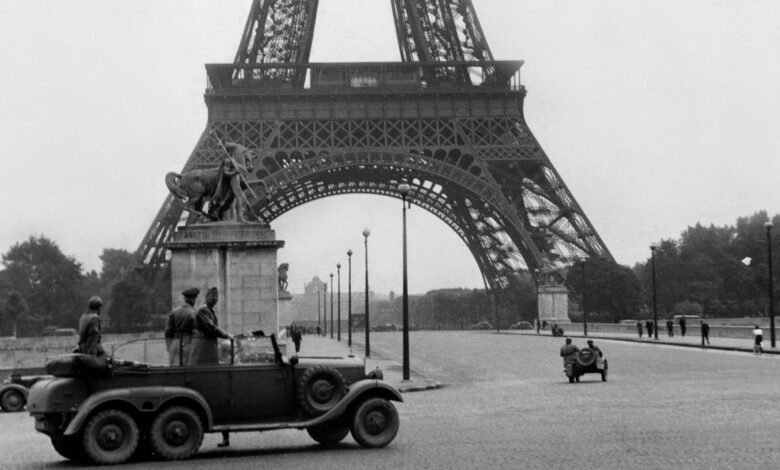The Mordant Intimacy of Cécile Desprairies’s “The Propagandist”

Years ago, a man who was then my fiancé gave me a mourning ring, inscribed with the name and dates of birth and death of a Frenchwoman who lived in the mid-eighteenth century. Strands of pale blonde hair are encased in its central setting, which is surrounded by tiny amethysts. I’d worn the ring with pleasure, though perhaps a bit thoughtlessly, until one autumn day when, on assignment in Paris to cover the Biennale des Antiquaires, I was introduced to the Marquis de Breteuil, a nattily dressed man with white hair and a kind demeanor, who looked at my ring and mistakenly assumed that the person it commemorated had been my ancestor. I mentioned the meeting, briefly, in the piece I wrote then, but the encounter stuck with me, making me wonder about the circuitous route by which this fragment of the ancien régime had made its way to my finger. What had befallen the woman’s rightful heirs? Had they lost their heads in the Terror?
We live in an era of increasing sensitivity to the provenance of artifacts and their restitution. Major museums in the West devoted to the presentation and preservation of art objects have fitfully begun acknowledging their ties to histories of violence and plunder. Who among us can truly claim immunity when the past comes calling?
Cécile Desprairies’s “The Propagandist,” which was published in France in August, 2023, and long-listed for that year’s Prix Goncourt, is a case in point. Deftly translated from the French by Natasha Lehrer, this début novel offers a thoroughgoing inventory of French complicity with the crimes of Nazi occupiers during the Second World War. Desprairies, a historian of Vichy France, focusses on a single French clan, modelled after her own family—their ill-begotten gains and misbegotten ideologies. The result is at once a ghost story, a tale of amour fou, a settling of accounts, and, one senses, a deeply personal act of expiation.
The narrator is a historian of Desprairies’s generation who recalls, with bitterness, dark humor, and a passion for accuracy that can be its own form of love, the characters who peopled her upper-middle-class, nineteen-sixties Parisian childhood. Some were mere “second-and-third-degree collaborators” during the war, content to look the other way and pursue their own advantage as Jews were systematically “relieved” of their property and positions in French society. Others, such as the narrator’s mother, Lucie—the novel’s central figure—were true believers in the Nazi cause. Yet they all remembered the Occupation as a Golden Age of opportunity and youthful idealism.
“The Propagandist” is also the story of the narrator’s efforts to understand and come to grips with this malignant legacy. Fascism, as it turns out, has a long half-life in families. As a young child, the narrator is kept guessing. Who were “our martyrs,” who a sign in the Bois de Boulogne indicates were executed there, beneath the branches of a tall oak tree? Who were “the bastards” that her mother, when prodded, would tell her had “condemned” the Vichy leaders Maréchal Philippe Pétain and Pierre Laval? Lucie invents illnesses to keep her daughter home from school in favor of a different education—during empty afternoons, she makes the child recite the names of German cities and rivers and conjugate irregular German verbs. These tangled associations take the narrator decades to unravel.
One of the most chilling scenes in the filmmaker Jonathan Glazer’s “The Zone of Interest”—a fictional re-creation of the domestic life of the Auschwitz commander Rudolph Höss—occurs when Höss’s wife, Hedwig, played by Sandra Hüller, closes herself in her bedroom to try on a fur coat. We first see the coat delivered, along with other garments, to the Höss family’s comfortable home, which lies just beyond the death camp’s perimeter. As Hedwig puts it on and turns side to side, gazing at her own reflection in a mirror, our thoughts inevitably turn to the coat’s prior owner, a woman never mentioned in the film, but almost certainly Jewish and murdered in the camp’s gas chambers on arrival. The familiarity of Hedwig’s gestures of feminine vanity is jarring, helping to bring the reality of this unseen horror home to us.
Like that film, “The Propagandist” also addresses the evils of Nazism indirectly, through the coded language of the narrator’s close female relatives, a coterie of women who gather most mornings to swap clothes and memories in her family’s apartment in the unfashionable but solidly bourgeois Seventeenth Arrondissement. Vying with each other in petty one-upmanship, they gossip in veiled terms about marital infidelities and “problems” that might be solved by sending “la petite”—the child narrator standing nearby and bearing silent witness—to “that nice pharmacist” to pick up a package.
“What was in the package?” Desprairies writes. “Potions to bring about abortions, black soap, rubber cords, addictive substances.” (Grandma, it should be noted, had a morphine habit.)
It would take a long time to unpack something else handed down to her during these morning rituals, as the women’s conversation inevitably turned to “the good times” when they were “living by their wits.” Their evasions when speaking of the war—artfully translated by Lehrer—offer a master class in euphemism. Their shorthand memories often focus on things. “ ‘Do you remember that lovely white organdie dress I wore to that party at the embassy?’ (I figured out eventually they meant the German embassy, but they were tight-lipped about the details.)” Or “ ‘You remember that pretty cherrywood half-moon table I helped myself to?’ (Said in a little girl’s tone of false contrition. I threw a discreet glance at the apartment’s mute furniture.)”
Lucie—the ringmaster of these morning meetings—is less inclined to frivolity. “Fascinating Fascism” is the title of Susan Sontag’s 1974 essay arguing against the postwar rehabilitation—then in full swing—of Leni Riefenstahl, Hitler’s favorite filmmaker. In “The Propagandist,” Lucie also fascinates. We first meet her in mid-life, a peremptory blonde, trained as a lawyer and profoundly bored by her role as an haute-bourgeois matron. Like the pampered, icy-blond housewife played by Catherine Deneuve in Luis Buñuel’s film “Belle de Jour” (1967), there is something a little off about her.
But Lucie’s secret isn’t that she spends her afternoons, like Deneuve’s character, servicing clients in a brothel. Instead, we learn that during the war, while working for the Vichy propaganda bureau, she fell madly in love with Friedrich, an Alsatian biologist and fervent Nazi. They married, and devoted themselves to the National Socialist cause. After Friedrich died, under murky circumstances, toward the end of the war, Lucie, a talented propagandist, pursued her own postwar rehabilitation, which included transatlantic stints working for Life and Vogue (details that Desprairies has confirmed in interviews to be true about her mother). She eventually remarried; her new husband was a successful executive who maintained a “very French-style antisemitism.” They had four children (including the narrator), but Lucie carried a torch for Friedrich and their shared vision of a new world order for six decades, until the day she died.
Though she never spoke about her first marriage, after her children were born and “she’d had it up to here with family life, Lucie started letting slip clues about her past”—naming her firstborn Frédéric and dressing him in lederhosen; offering her brood, at snack time, “a piece of rye bread sliced with a deer horn knife and spread with lard.” For herself, there were “tall polished boots in fawn leather that she liked to wear, a little incongruously, about town.” Seen through the eyes of her young daughter, the Lucie that emerges from these pages is at once larger than life and vulnerable, but either way impossible to cut down to proper size.
Desprairies, who was born in Paris in 1957, studied philosophy and literature and first worked as a Germanist in educational publishing, before becoming a historian of Vichy. Since 2008, she’s published a series of nonfiction books, deeply researched and copiously illustrated with archival photographs: on sites in Paris that enabled the collaboration (storied publishing houses that turned to printing propaganda, elegant apartment buildings where the Gestapo tortured members of the Resistance); on laws and national holidays dating from Vichy, such as Mother’s Day, that are still observed in France today; and on German propaganda that, like a Potemkin village made of posters, provided cover for the Occupation’s grim privations. A volume that she published just last year, tracing the topography of collaboration in locations across France, runs to more than a thousand pages.
Turning to fiction for the first time with “The Propagandist,” she faced a very different challenge—allowing readers to identify with the human foibles of characters on the wrong side of history, while never excusing them. Such an intimate portrait could only have been written from inside this secretive community.
To discharge without diluting her radioactive family history, Desprairies armed herself with irony. When Lucie first meets Friedrich, for example, in the winter of 1940, she’s already begun to dye her hair blond. But by late spring her hair is “growing gradually lighter with the advance of the German army.” Other characters condemn Lucie, but for the wrong reasons. The narrator’s great-uncle Raphäel, an opportunist, aesthete, and music impresario who profits wildly during the Occupation but manages to escape postwar reprisals, finds his niece Lucie too idealistic: “As far as he was concerned, she was a bit of a silly goose, looking for love instead of prosperity. And from a financial point of view, her antisemitism had been a failure. She had not managed to make a cent out of it.”
To whom does history belong? What stories are most urgent to tell, and when? Primo Levi began writing his first memoir, “Survival in Auschwitz,” while still a prisoner, at work in the death camp’s chemistry lab. He knew it was too dangerous to save the pages he had scribbled in secret, but he completed his manuscript within a few months of his liberation. The literature of the Resistance in France also began during the war and the Occupation, with the clandestine publication of the novella “The Silence of the Sea,” by Vercors (a pseudonym for Jean Brullers, a co-founder of the then underground publishing house Les Éditions de Minuit).
Some eighty years after the war’s end, stories are beginning to emerge about “ordinary” collaborators in Occupied France, the people who were complicit, either by offering no objection to or by actively advancing the great wave of fascism sweeping through Europe. They may at first have seen “the good” in German fascism, as the writer Burkhard Bilger’s grandfather, a school teacher in German-occupied Alsace, did. (“He was a Nazi, but a reasonable one,” a former student recalls, in Bilger’s recent memoir, “Fatherland.”) Or else, as the war progressed, they switched allegiances in a mad scramble for survival, like the father of the French writer Sorj Chalandon, whose still untranslated 2022 autofiction, “Enfant de Salaud,” tells the story of an eighteen-year-old French soldier for hire who wore five different uniforms during the four years of the war, deserting opposing armies repeatedly.
Desprairies may have needed to wait for an entire generation of family members to die before capturing them on the page. (She has admitted that she had to leave French soil to do so, writing the book in a borrowed apartment in Vienna.) In the novel, the objects that the narrator has inherited from family—“beautiful things, some of which seem to have come from the pillaging of all Europe, not just Vichy France”—haunt her. “I have only to stumble upon an old key at the back of a drawer to wonder about the person who left it there.” ♦





